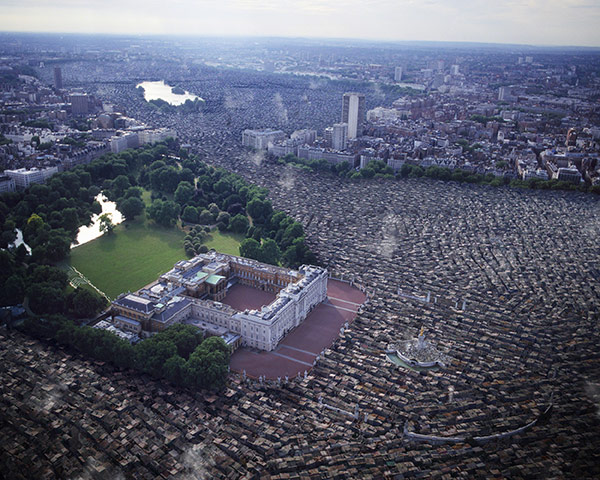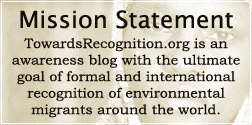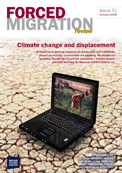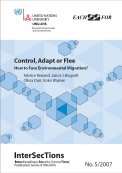
An image from the London Futures exhibition showing Buckingham palace surrounded by a vast shantytown. Photo credit: Jason Hawkes/Museum of London
(The Guardian) October 27, 2010 – The effects of climate change are so hard to imagine that we should welcome an exhibition of Postcards from the Future that promises “Images that bring ideas to life and frame the climate debate in a way that everyone can understand”. Unfortunately the debate it frames is dangerous and the main reason that it can be readily understood is that it fits all too easily with existing prejudices.
The pictures are artfully composed photomontages that juxtapose iconic London landmarks with eye-catching climate impacts – for example the Household Cavalry ride down a sand-strewn Whitehall on camels; an oil palm plantation grows in Hyde Park; and people skate on the Thames after the Gulf Stream packs in.
The creators, Robert Graves and Didier Madoc-Jones, assure us that they “researched different scientific projections”. Really? Not one of these images reflects any real climate scenario for London. They are pure science-fiction.
Certainly they are striking and win attention, but at a price. Public acceptance of climate change is still weak and 55% of people believe that climate change has been exaggerated for political ends. Fantasy images actively feed that public denial
and with it the widespread assumption that climate change is conjectural and without firm basis in fact.
However the greatest concern with this show is not that it parts with reality, but that it speaks all too well to real prejudices against immigrants “swamping” British culture. This is a recurring theme. One postcard shows Asian peasants working in paddy fields in the shadow of Big Ben. Two postcards in the series show shantytowns around Nelson’s Columnand Buckingham Palace.
These images cause deep disquiet for those who work with refugees and immigrants. Jonathan Ellis, policy director at the Refugee Council, calls them “lazy and unhelpful” at a time when “we need fresh and creative messages, and a fair and rational debate based on the facts”.
“Producing sensationalist pictures which fall back on cheap stereotypes of refugees do not help anyone’s cause,” says Vaughan Jones, the chief executive of Praxis, a London-based charity that provides practical support for refugees and asylum seekers. “The issue is too serious for this inaccurate treatment.”
Hannah Smith from the Climate Outreach Information Network runs a programme that brings together over 30 refugee, human rights and environment organisations. She argues that the images give an entirely erroneous impression and that “the actual patterns of migration are far more likely to be the movement of people inside existing national borders, or, in the case of the UK, from within the European Union. To suggest that there will be mass migration from the [global] south is misleading and feeds xenophobia.”
These concerns are exacerbated by the language used in the captions. The caption for the Buckingham Palace shantytown talks of the royal family being surrounded by “overwhelming numbers of immigrants”. Another caption, for a picture of monkeys on the balustrade of St Paul’s Cathedral describes them as “a new breed of tropical immigrants reminiscing about equatorial days”. This is a misapplication of language that Hannah Smith regards as deeply insulting.
When I look at the postcards from the perspective of refugee organisations these criticisms seem entirely sensible and self-evident. And they raise a fascinating question: why did the cover story of “climate change” permit the enthusiastic promotion of images and language that would be normally be considered unacceptable in a public exhibition?
One reason is that we have already come to “frame” climate change in this way. Impacts are invariably presented as the crude data of square kilometres flooded or numbers of people displaced. There is still a painful lack of elaboration or analysis of the real political and social impacts of these changes – who will be affected, how will they adapt and where will they go.
This in turn reflects the disturbingly limited range of voices that can be heard talking about climate change. While environmentalists have dominated the public discourse from the outset, it has only been in the past five years that development organisations and unions have become involved.
Human rights and refugee organisations are only now fully recognising the importance of climate change and they are struggling to find their niche and be heard on the issue. “We operate under such constant pressures, both internally and externally, that we have been in the bunker for far too long”, says Jonathan Ellis.
Even the core term “climate refugee”, used universally by environmental organisations and throughout the postcard captions, is inaccurate, argues Vaughan Jones. It took decades of hard campaigning to get refugees protected under international law and “the term must be preserved as a legal status for those fleeing persecution”.
None of this is to doubt the sincerity of the photo-artists or those organising the exhibition. Nor does it imply that climate change is so complex that it cannot be communicated to the general public. All it shows is that climate change is a challenging area, framed by denial, guilt and discrimination, that requires the same intelligence and sensitivity as any exhibition on gender, race or class.
Source: The Guardian



